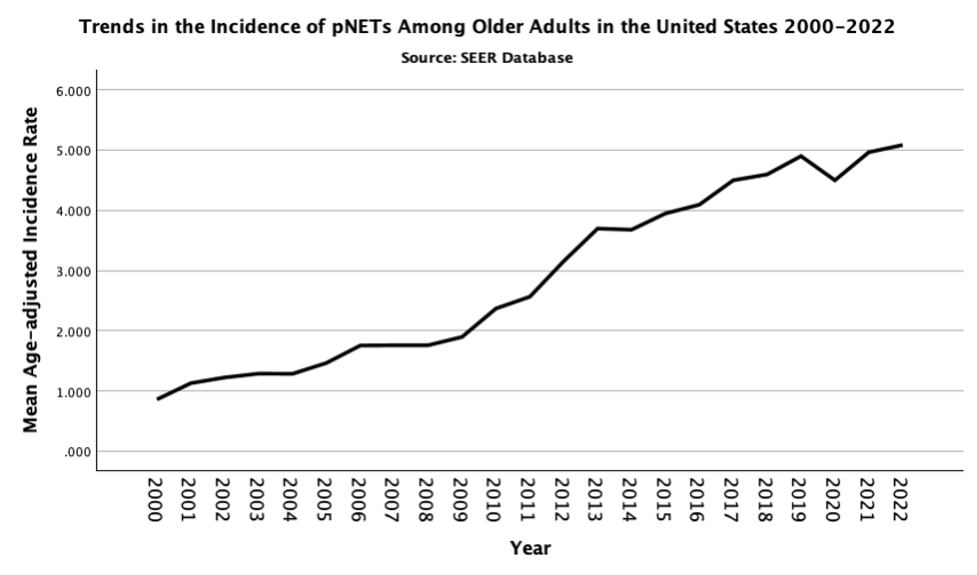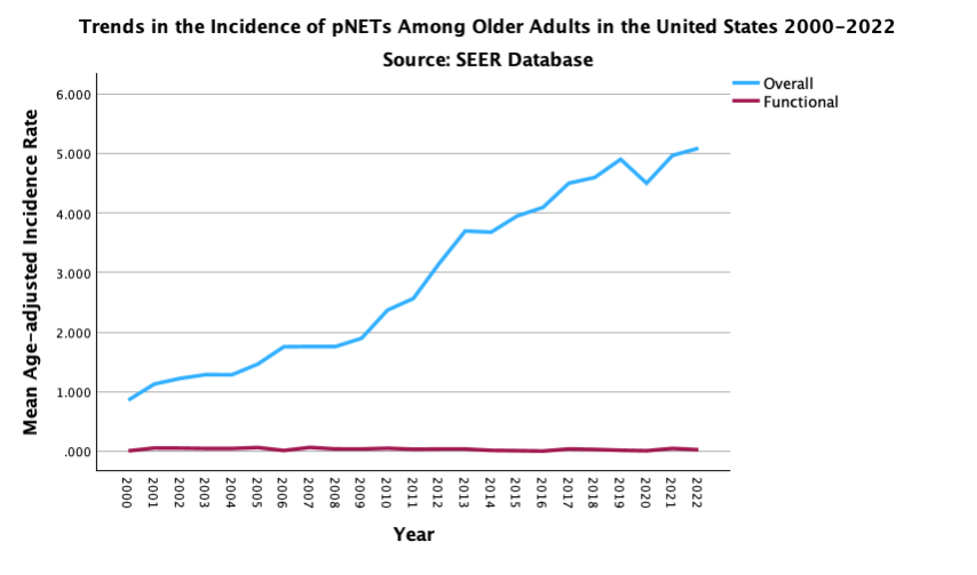Monday Poster Session
Category: Biliary/Pancreas
P2198 - Trends in Pancreatic Neuroendocrine Tumors Among Older Adults in the United States: A Population-Based Analysis
Monday, October 27, 2025
10:30 AM - 4:00 PM PDT
Location: Exhibit Hall

Zoilo K. Suarez, MD (he/him/his)
University of Arizona
Chandler, AZ
Presenting Author(s)
Zoilo K.. Suarez, MD1, Lucas Hernandez, MD2, Raghav Bassi, MD3, Juan Reyes Genere, MD4, David G. Forcione, MD5
1University of Arizona, Chandler, AZ; 2University of Cincinnati, Cincinnati, OH; 3AdventHealth, Orlando, FL; 4Washington University School of Medicine in St. Louis, St. Louis, MO; 5Boca Raton Regional Hospital, Boca Raton, FL
Introduction: Pancreatic neuroendocrine tumors (pNETs) are rare neoplasms that are increasingly diagnosed in the US. Although national datasets aim to provide surveillance, detailed epidemiologic patterns remain uncharacterized among older adults. This study evaluates the age-adjusted incidence trends and demographic disparities in pNETs across the US.
Methods: Data from the Surveillance, Epidemiology, and End Results (SEER) program were analyzed from 2000 to 2022 to estimate the age-adjusted incidence rates of pNETs per 100,000 population. Using ICD codes, we identified 13,037 adults aged ≥65 diagnosed with pNET between 2000 and 2022. Incidence rates were stratified by sex, geographic areas, and race. One-way analysis of variance (ANOVA) was used to evaluate differences across racial/ethnic groups, while independent two-sample t-tests assessed differences between sex and type of residence areas.
Results: The age-adjusted incidence of pNETs among older adults increased substantially from 0.86 per 100,000 in 2000 to 5.08 in 2022. Older males had a higher age-adjusted incidence rate than older females (3.73 vs 2.24; P < 0.05). Among racial groups, no significant differences were found between non-Hispanic Whites, non-Hispanic Blacks, Hispanics, non-Hispanic Asian or Pacific Islanders, and non-Hispanic American Indian/Alaska Natives (P=0.137). There were similar age-adjusted incidence rates between older adults living in metropolitan areas compared to rural settings (2.96 vs 2.46; P = 0.234). Likewise, the rate of functional pNETs remained similar during the study period.
Discussion: The incidence of pNETs in older adults has been increasing over the last two decades. Given the vast overrepresentation of nonfunctional lesions, these observations likely represent a rise in incidental detection of lesions. Further study is required to validate these findings and determine best practices for evaluating and managing pNETs in the geriatric population.

Figure: Figure 1

Figure: Figure 2
Disclosures:
Zoilo Suarez indicated no relevant financial relationships.
Lucas Hernandez indicated no relevant financial relationships.
Raghav Bassi indicated no relevant financial relationships.
Juan Reyes Genere indicated no relevant financial relationships.
David Forcione indicated no relevant financial relationships.
Zoilo K.. Suarez, MD1, Lucas Hernandez, MD2, Raghav Bassi, MD3, Juan Reyes Genere, MD4, David G. Forcione, MD5. P2198 - Trends in Pancreatic Neuroendocrine Tumors Among Older Adults in the United States: A Population-Based Analysis, ACG 2025 Annual Scientific Meeting Abstracts. Phoenix, AZ: American College of Gastroenterology.
1University of Arizona, Chandler, AZ; 2University of Cincinnati, Cincinnati, OH; 3AdventHealth, Orlando, FL; 4Washington University School of Medicine in St. Louis, St. Louis, MO; 5Boca Raton Regional Hospital, Boca Raton, FL
Introduction: Pancreatic neuroendocrine tumors (pNETs) are rare neoplasms that are increasingly diagnosed in the US. Although national datasets aim to provide surveillance, detailed epidemiologic patterns remain uncharacterized among older adults. This study evaluates the age-adjusted incidence trends and demographic disparities in pNETs across the US.
Methods: Data from the Surveillance, Epidemiology, and End Results (SEER) program were analyzed from 2000 to 2022 to estimate the age-adjusted incidence rates of pNETs per 100,000 population. Using ICD codes, we identified 13,037 adults aged ≥65 diagnosed with pNET between 2000 and 2022. Incidence rates were stratified by sex, geographic areas, and race. One-way analysis of variance (ANOVA) was used to evaluate differences across racial/ethnic groups, while independent two-sample t-tests assessed differences between sex and type of residence areas.
Results: The age-adjusted incidence of pNETs among older adults increased substantially from 0.86 per 100,000 in 2000 to 5.08 in 2022. Older males had a higher age-adjusted incidence rate than older females (3.73 vs 2.24; P < 0.05). Among racial groups, no significant differences were found between non-Hispanic Whites, non-Hispanic Blacks, Hispanics, non-Hispanic Asian or Pacific Islanders, and non-Hispanic American Indian/Alaska Natives (P=0.137). There were similar age-adjusted incidence rates between older adults living in metropolitan areas compared to rural settings (2.96 vs 2.46; P = 0.234). Likewise, the rate of functional pNETs remained similar during the study period.
Discussion: The incidence of pNETs in older adults has been increasing over the last two decades. Given the vast overrepresentation of nonfunctional lesions, these observations likely represent a rise in incidental detection of lesions. Further study is required to validate these findings and determine best practices for evaluating and managing pNETs in the geriatric population.

Figure: Figure 1

Figure: Figure 2
Disclosures:
Zoilo Suarez indicated no relevant financial relationships.
Lucas Hernandez indicated no relevant financial relationships.
Raghav Bassi indicated no relevant financial relationships.
Juan Reyes Genere indicated no relevant financial relationships.
David Forcione indicated no relevant financial relationships.
Zoilo K.. Suarez, MD1, Lucas Hernandez, MD2, Raghav Bassi, MD3, Juan Reyes Genere, MD4, David G. Forcione, MD5. P2198 - Trends in Pancreatic Neuroendocrine Tumors Among Older Adults in the United States: A Population-Based Analysis, ACG 2025 Annual Scientific Meeting Abstracts. Phoenix, AZ: American College of Gastroenterology.

